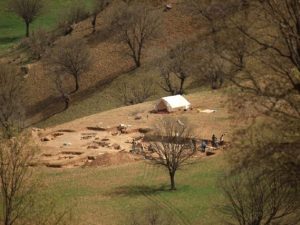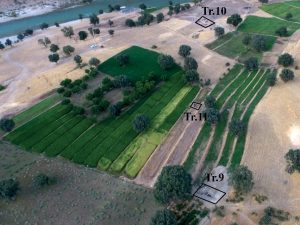Deh Domenده دومن
Location: The archaeological site of Deh Domen is 70 km northwest of the city of Yasuj, southwestern Iran, of Kohgilūyeh and Boyerahmad Province.
31° 9’ 13’’ N 51° 6’ 14’’ E
Map
Historical Period
Bronze Age
History and description
The archaeological site of Deh Domen is situated in the vicinity of a village of the same name on the southern bank of the Khersān River, 70 km northwest of the city of Yasuj. The area is dotted with archaeological remains ranging in date from the Ilkhanid/Timurid period to the Middle Bronze Age period. The archaeological site includes a ruined castle known as Qal’eh Yel and a mound named Saheb Ali Tepe on the surface of which there were large Bronze Age graves (fig. 1). The graveyard stretched over a length of 1000 m, has suffered from farming activities (Naseri, “The Third Season of Excavations at Deh Pāyin (Deh Doman) Graveyard,” p. 72). A total of 36 inhumations have been uncovered in three excavation seasons between 2013 and 2019 (fig. 2). Based on the grave goods, it seems that the graveyard was in use for a long period from the mid-third to the mid-first millennium B.C. Further research showed that the graveyard lay on a natural hill (Saheb Ali Tepe). Remnants of the bases of three jars were also found that could not be recognized as burial jars (Oudbashi, Naseri, Malekzadeh, “Technical Studies on the Bronze Age Metal Artefacts,” p. 948).
Archaeological Exploration
Because of the proximity of the site to the construction location of a dam on the Khersān river, a team of archaeologists led by Reza Naseri carried out three seasons of rescue excavations on behalf of the Iranian Center for Archaeological Research in 2013, 2016, and 2019 (Naseri, “Kāvosh-e nejātbakhshi-ye mohavatteh va gūrestān-e bāstāni-ye Deh Domen,” p. 8; Naseri et al., “Kāvosh-e nejātbakhshi-ye mohavatteh va gūrestān-e bāstāni-ye Deh Domen,” p. 423).
Finds
Thirty-six graves have been excavated at the site, of which some had been looted either in antiquity or in modern times (fig. 3). The graves are of two types: a box-shaped flat-roofed grave, and gabled roof graves (fig. 4). Grave goods consist of pottery (fig. 5), bronze objects such as vessels (fig. 6) and weapons (fig. 7), and stone vessels (fig. 8).
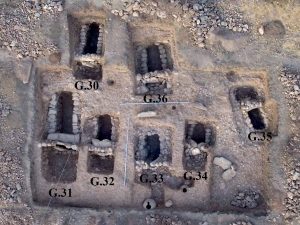
Fig. 3. The graveyard at Deh Domen. The aerial view of Trench 2 (after Naseri, “The Third Season of Excavations at Deh Pāyin (Deh Doman) Graveyard,” p. 74, fig. 2).
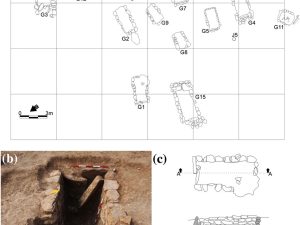
Fig. 4. (a) Plan of the excavated area with 15 Bronze Age graves; (b) One of the Bronze Age graves with sidewalls in stone; (c) the top plan and section of the same grave (after Oudbashi, Naseri, and Malekzadeh, “Technical Studies,” p. 950, fig. 2).
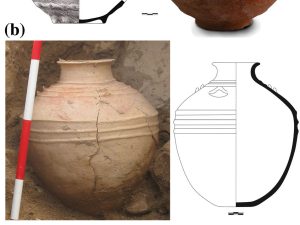
Fig. 5. Pottery vessels from Deh Domen. (a) a jar from grave no. 4; (b) a jar found in grave no. 15; (c) monochrome painted pottery from grave no. 7. (after Oudbashi, Naseri, and Malekzadeh, “Technical Studies,” p. 951, fig. 3).
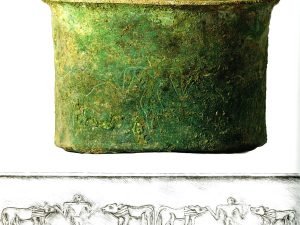
Fig. 6. Bronze vessel decorated with figures of a human flanked by two animals (after Naseri, “Kāvosh-e nejātbakhshi-ye mohavatteh va gūrestān-e bāstāni-ye Deh Domen,” p. 9.
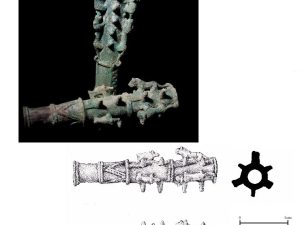
Fig. 7. Bronze mace head with lion and boar figures (after Naseri, “The Third Season of Excavations at Deh Pāyin (Deh Doman) Graveyard,” p. 75.
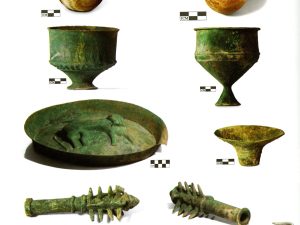
Fig. 8. A collection of finds from Deh Domen’s graves, including stone and bronze vessels (after Naseri, “Kāvosh-e nejātbakhshi-ye mohavatteh va gūrestān-e bāstāni-ye Deh Domen,” p. 11).
Bibliography
Naseri, R., “Kāvosh-e nejātbakhshi-ye mohavatteh va gūrestān-e bāstāni-ye Deh Domen,” The 12th Annual Symposium on Iranian Archaeology, 2011. The exhibition of finds catalogue, M. Mosala (ed.), Tehran, 1391/2011, pp. 8-11.
Naseri et al., “Kāvosh-e nejātbakhshi-ye mohavatteh va gūrestān-e bāstāni-ye Deh Domen,” The 12th Annual Symposium on Iranian Archaeology, 2011, short articles, M. Gholami and K. Rusta’i (eds.), Tehran, 1393/2014, pp. 423-426.
Naseri, R., “The Third Season of Excavations at Deh Pāyin (Deh Doman) Graveyard,” A Collection of Archaeological Finds from Excavations in 2019-2020. The 18th Annual Symposium on Iranian Archaeology (2021), M. Mosalla (ed.), Tehran, 2021, pp. 72-78.
Oudbashi, O., Naseri, R., and Malekzadeh, M., “Technical Studies on the Bronze Age Metal Artefacts from the Graveyard of Deh Dumen, South-western Iran (Third Millennium BC)”, Archaeometry, vol. 58/6, 2016, pp. 947–965.


